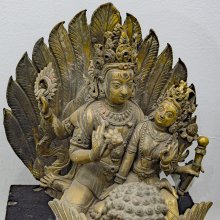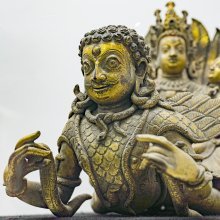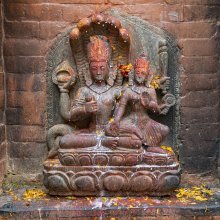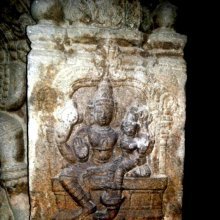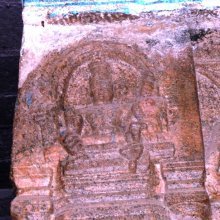Lakshminarayana, Lakṣmīnārāyaṇa, Lakshmi-narayana: 7 definitions
Introduction:
Lakshminarayana means something in Hinduism, Sanskrit, the history of ancient India. If you want to know the exact meaning, history, etymology or English translation of this term then check out the descriptions on this page. Add your comment or reference to a book if you want to contribute to this summary article.
The Sanskrit term Lakṣmīnārāyaṇa can be transliterated into English as Laksminarayana or Lakshminarayana, using the IAST transliteration scheme (?).
Images (photo gallery)
(+3 more images available)
In Hinduism
Shilpashastra (iconography)
Source: archive.org: Pratima Kosa Encyclopedia of Indian Iconography - Vol 6Lakṣmīnārāyaṇa (लक्ष्मीनारायण) refers to one of the many varieties of the Śālagrāma (ammonite fossil stones).—The Lakṣmīnārāyaṇa stone has one opening with four cakras; colour of rain-bearing cloud (navīna-niradābha); line suggesting vanamālā. Without vanamālā, it will be known as Lakṣmī-janārdana. Śālagrāma stones are very ancient geological specimens, rendered rounded and smooth by water-currents in a great length of time. They (e.g., Lakṣmī-nārāyaṇa stones) are distinguished by the ammonite (śālā, described as “vajra-kīṭa”, “adamantine worms”) which having entered into them for residence, are fossilized in course of time, leaving discus-like marks inside the stone.
Source: Shodhganga: The significance of the mūla-beras (śilpa)Lakṣmī Nārāyaṇa is the name of a deity depicted at the Kallazhagar Temple in Madurai, which represents a sacred place for the worship of Viṣṇu.—Lakṣmī Nārāyaṇa is also represented in the same way as Bhūmī Varāha, but the face is shown like that of Viṣṇu. Then there is the sannidhi of Ānṭāl, Raṅgamannar and Garuḍālvār. Ānṭāl, Raṅgamannar and Garuḍālvār is also described in the sannidhi of Ānṭāl in Śrī Villiputtur. Then there is the sannidhi of Pārthasārathī.
Lakṣmī Nārāyaṇa is also depicted at the Andal Temple in Srivilliputtur (Villiputtur or Thiruvilliputtur), representing a sacred place for the worship of The Goddess (Devī).—Lakṣmī Nārāyaṇa is found seated in the sukhāsana posture with Lakṣmī seated on his left thigh. He is represented with four hands. The upper right hand holds the discus and the upper left hand holds the conch in kartarīmukha-hasta. The lower right hand is in vyākhyāna-hasta. The lower left hand of Lakṣmī Nārāyaṇa holds Lakṣmī around her waist with pustaka in his left palm. The hasta held is muṣṭi. While depicting in Bharatanatyam, Lakṣmī Nārāyaṇa is found in aindra maṇḍala as if seated on a pedestal. He is represented with four hands. The upper two hands are in kartarīmukha-hasta. The lower right hand is in haṃsāsya hasta and the lower left hand in muṣṭi.

Shilpashastra (शिल्पशास्त्र, śilpaśāstra) represents the ancient Indian science (shastra) of creative arts (shilpa) such as sculpture, iconography and painting. Closely related to Vastushastra (architecture), they often share the same literature.
India history and geography
Source: What is India: Inscriptions of the ŚilāhārasLakṣmīnārāyaṇa is the name of a god mentioned in the “Bassein stone inscription of Anantadeva II”. Accordingly, “... this day, here, in the presence of the divine Lakṣmīnārāyaṇa installed by the Mahāmātya, the illustrious Lakṣmīdhara, Soma Ṭhākura has donated... at the holy place of Māṇḍavāli”.
This stone inscription (mentioning Lakṣmīnārāyaṇa) was found at Mānḍavī, 15 miles north-east of Bassein in the Ṭhāṇā District. It records some gift at the Māṇḍavalī-tīrtha in the presence of the god Lakṣmīnārāyaṇa installed by the Mahāmātya Lakṣmīdhara of Keśideva. It is dated in the year 1125 (evidently of the Śaka era), the cyclic year being Rudhirodgārī, on the 15th tithi of the bright fortnight of Māgha.

The history of India traces the identification of countries, villages, towns and other regions of India, as well as mythology, zoology, royal dynasties, rulers, tribes, local festivities and traditions and regional languages. Ancient India enjoyed religious freedom and encourages the path of Dharma, a concept common to Buddhism, Hinduism, and Jainism.
Languages of India and abroad
Sanskrit dictionary
Source: Cologne Digital Sanskrit Dictionaries: Aufrecht Catalogus Catalogorum1) Lakṣmīnārāyaṇa (लक्ष्मीनारायण) as mentioned in Aufrecht’s Catalogus Catalogorum:—father of Lakṣmīdatta (Pāṇḍavacarita). L. 2004.
2) Lakṣmīnārāyaṇa (लक्ष्मीनारायण):—Upaśamāryā. Kāśīstotra. Kṛṣṇāṣṭaka. Devyaṣṭaka. Nīrājanapadyālilakṣaṇavivikti. Pāṃsulāvṛttiprakāśa. Prātaḥsmaraṇāṣṭaka. Bhāratīnīrājana. Maṅgaladaśaka Madanamukhacapeṭā. Rāmacandrapañcadaśī. Rāmapañcadaśīkalpalatikā. Vindhyavāsinīdaśaka. Viśveśvaranīrājana. Viṣṇunīrājana. Śaṅkarāṣṭaka. Śivadaśaka. Śivastotra. Sūryaṣaṭpadī.
3) Lakṣmīnārāyaṇa (लक्ष्मीनारायण):—Tattvaprakāśikāvyākhyā, vedānta. Khn. 56.
4) Lakṣmīnārāyaṇa (लक्ष्मीनारायण):—Dāyādhikārikrama. Sūcīpattra. 30.
5) Lakṣmīnārāyaṇa (लक्ष्मीनारायण):—Laghusaṃgraha jy.
6) Lakṣmīnārāyaṇa (लक्ष्मीनारायण):—Śrutabodhaṭīkā.
7) Lakṣmīnārāyaṇa (लक्ष्मीनारायण):—father of Kṛpārāma (Bījodāharaṇabālabodhinī 1792).
8) Lakṣmīnārāyaṇa (लक्ष्मीनारायण):—Gorakṣaśatakaṭīkā.
Source: Cologne Digital Sanskrit Dictionaries: Monier-Williams Sanskrit-English Dictionary1) Lakṣmīnārāyaṇa (लक्ष्मीनारायण):—[=lakṣmī-nārāyaṇa] [from lakṣmī > lakṣ] m. [dual number] or n. sg. L° and Nārāyaṇa, [Hemādri’s Caturvarga-cintāmaṇi] (cf. [Religious Thought and Life in India 151; 184])
2) [v.s. ...] m. Name of a prince, [Inscriptions]
3) [v.s. ...] (also with nyāyālaṃkāra, paṇḍita, yati) of various authors and other men, [Catalogue(s)]
4) [v.s. ...] mfn. belonging to L° and Nārāyaṇa, [Hemādri’s Caturvarga-cintāmaṇi]
[Sanskrit to German]
Sanskrit, also spelled संस्कृतम् (saṃskṛtam), is an ancient language of India commonly seen as the grandmother of the Indo-European language family (even English!). Closely allied with Prakrit and Pali, Sanskrit is more exhaustive in both grammar and terms and has the most extensive collection of literature in the world, greatly surpassing its sister-languages Greek and Latin.
See also (Relevant definitions)
Partial matches: Lakshmi, Narayana.
Starts with (+2): Lakshminarayana nyayalamkara, Lakshminarayana pandita, Lakshminarayana yati, Lakshminarayana-chettu, Lakshminarayanachettu, Lakshminarayanachetu, Lakshminarayanadasa, Lakshminarayanahridaya, Lakshminarayanakavaca, Lakshminarayanan, Lakshminarayanapaddhati, Lakshminarayanapancanga, Lakshminarayanapatala, Lakshminarayanapujavidhana, Lakshminarayanarcakaumudi, Lakshminarayanasahasranaman, Lakshminarayanasamvada, Lakshminarayanastava, Lakshminarayanastotra, Lakshminarayanavrata.
Ends with: Paralakshminarayana.
Full-text (+40): Bharatinirajana, Lakshmi-narayana-chettu, Lakshminarayanastava, Lakshminarayanasamvada, Lakshminarayanahridaya, Lakshminarayanapancanga, Lakshminarayanastotra, Lakshminarayanapujavidhana, Lakshminarayanavratakalpa, Lakshminarayanasahasranaman, Lakshminarayanavrata, Shamkarashtaka, Lakshminarayanarcakaumudi, Lakshminarayana pandita, Kayasthakshatriyatvadrumadalanakuthara, Dayadhikarikrama, Madanamukhacapeta, Devyashtaka, Pamsulavrittiprakasha, Lakshminarayana-chettu.
Relevant text
Search found 22 books and stories containing Lakshminarayana, Lakṣmīnārāyaṇa, Lakshmi-narayana, Lakṣmī-nārāyaṇa, Laksminarayana, Laksmi-narayana; (plurals include: Lakshminarayanas, Lakṣmīnārāyaṇas, narayanas, nārāyaṇas, Laksminarayanas). You can also click to the full overview containing English textual excerpts. Below are direct links for the most relevant articles:
Chaitanya Bhagavata (by Bhumipati Dāsa)
Verse 1.14.28 < [Chapter 14 - The Lord’s Travel to East Bengal and the Disappearance of Lakṣmīpriyā]
Verse 1.15.214 < [Chapter 15 - Marriage with Śrī Viṣṇupriyā]
Verse 1.14.48 < [Chapter 14 - The Lord’s Travel to East Bengal and the Disappearance of Lakṣmīpriyā]
A Poet’s Host < [January – March, 2001]
A Prose-Epic < [May, 1928]
Who’s Who Among our Contributors < [January – March, 2001]
Temples in and around Madurantakam (by B. Mekala)
Sri Lakshminarayana Perumal Temple < [Chapter 3 - Temples of Madurantakam Taluk]
Jainism in Odisha (Orissa) (by Ashis Ranjan Sahoo)
Santinatha image at Paramanandapur < [Chapter 3: Survey of Jaina Antiquities in Odisha]
Pallava period (Social and Cultural History) (by S. Krishnamurthy)
The custom of Sati < [Chapter 3 - Socio-Religious Life]
Vaishnavism during the Pallava period < [Chapter 3 - Socio-Religious Life]
The Skanda Purana (by G. V. Tagare)
Chapter 255 - Greatness of Lakṣmī-Nārāyaṇa < [Section 1 - Tīrtha-māhātmya]
Chapter 37 - The Ultimate and Eternal Sudarśana Cakra on Stone at Dvārakā < [Section 4 - Dvārakā-māhātmya]
Chapter 10 - Glorification of the Gift of Umbrellas: The Story of Hemakānta < [Section 7 - Vaiśākhamāsa-māhātmya]
Related products
